|
|
|
Sort Order |
|
|
|
Items / Page
|
|
|
|
|
|
|
| Srl | Item |
| 1 |
ID:
094189
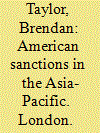

|
|
|
|
|
| Publication |
London, Routledge, 2010.
|
| Description |
ix, 170p.
|
| Series |
Routledge security in Asia Pacific series ; 14
|
| Standard Number |
9780415423502
|
|
|
|
|
|
|
|
|
|
|
|
Copies: C:2/I:0,R:0,Q:0
Circulation
| Accession# | Call# | Current Location | Status | Policy | Location |
| 054811 | 327.117/TAY 054811 | Main | On Shelf | General | |
| 056717 | 327.117/TAY 056717 | Main | On Shelf | General | |
|
|
|
|
| 2 |
ID:
105716
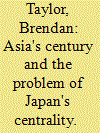

|
|
|
|
|
| Publication |
2011.
|
| Summary/Abstract |
Japan has long been regarded as a central component of America's grand strategy in Asia. Scholars and practitioners assume this situation will persist in the face of China's rise and, indeed, that a more 'normal' Japan can and should take on an increasingly central role in US-led strategies to manage this power transition. This article challenges those assumptions by arguing that they are, paradoxically, being made at a time when Japan's economic and strategic weight in Asian security is gradually diminishing. The article documents Japan's economic and demographic challenges and their strategic ramifications. It considers what role Japan might play in an evolving security order where China and the US emerge as Asia's two dominant powers by a significant margin. Whether the US-China relationship is ultimately one of strategic competition or accommodation, it is argued that Japan's continued centrality in America's Asian grand strategy threatens to become increasingly problematic. It is posited that the best hope for circumventing this problem and its potentially destabilizing consequences lies in the nurturing of a nascent 'shadow condominium' comprising the US and China, with Japan as a 'marginal weight' on the US side of that arrangement.
|
|
|
|
|
|
|
|
|
|
|
|
|
|
|
|
| 3 |
ID:
052971
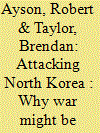

|
|
|
|
|
| Publication |
Jul-Sep 2004.
|
|
|
|
|
|
|
|
|
|
|
|
|
|
|
|
| 4 |
ID:
183513


|
|
|
|
|
| Summary/Abstract |
Australian strategic studies scholars have traditionally made an outsized impact on the world stage. This reflection upon the past, present and future of their field begins by seeking to explain why. It then takes stock of Australian strategic studies today, finding a flourishing field that stacks up remarkably well, even when measured against the exploits of its illustrious past. The essay concludes by identifying the main challenges and opportunities facing Australian strategic studies going forward, suggesting possible approaches for addressing these.
|
|
|
|
|
|
|
|
|
|
|
|
|
|
|
|
| 5 |
ID:
080924
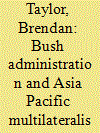

|
|
|
|
|
| Publication |
2008.
|
| Summary/Abstract |
This article challenges the presumed multilateral aversion of the George W. Bush administration. It argues that, at least in its approach toward the Asia-Pacific, this administration has been a more active and stimulatory advocate of multilateral approaches than is commonly acknowledged. The article begins by documenting the Bush administration's multilateral activism in the Asia-Pacific and examines those factors which appear to have contributed towards it. It then goes on to demonstrate, however, that Bush's at times unexpected enthusiasm for multilateral approaches has encountered a high degree of regional reticence. For a part of the world that has been affording an increased prominence to multilateral institutions and activities, this finding is initially both surprising and significant. The article concludes by seeking to account for this apparent anomaly and by considering its possible implications for the emerging regional architecture.
|
|
|
|
|
|
|
|
|
|
|
|
|
|
|
|
| 6 |
ID:
137620
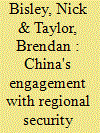

|
|
|
|
|
| Summary/Abstract |
Using a case study of Beijing’s participation in the Shangri-La Dialogue, a prominent annual security gathering in Singapore, this article analyses China’s approach to Asian security multilateralism. It does so by developing and employing a typology consisting of four characterizations of multilateral engagement: China as “blocker”; China as “socialized participant”; China as “shaper”; and China as “opportunistic participant”. The article shows that in its approach to the Shangri-La Dialogue, China displays all four of these traits, while noting that some are more prevalent and compelling at certain points in time. It uses this finding to draw conclusions about Beijing’s future engagement with the Shangri-La Dialogue and its broader approach to security multilateralism. It also contributes to the larger debate over whether China is a “revisionist” or a “status quo” rising power.
|
|
|
|
|
|
|
|
|
|
|
|
|
|
|
|
| 7 |
ID:
168145
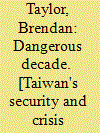

|
|
|
|
|
| Publication |
Oxon, Routledge, 2019.
|
| Description |
147p.pbk
|
| Series |
Adelphi Series; 470-471
|
| Standard Number |
9780367437480
|
|
|
|
|
|
|
|
|
|
|
|
Copies: C:1/I:0,R:0,Q:0
Circulation
| Accession# | Call# | Current Location | Status | Policy | Location |
| 059718 | 355.033051249/TAY 059718 | Main | On Shelf | General | |
|
|
|
|
| 8 |
ID:
176240
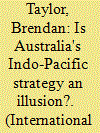

|
|
|
|
|
| Summary/Abstract |
Australia has been among the most prominent advocates of the increasingly popular Indo-Pacific concept. This article argues that Canberra's enthusiasm for the concept stems from its appeal to the two dominant traditions of Australian foreign policy—a ‘dependent ally’ tradition and a ‘middle power’ approach. While these two traditions are typically seen as being in tension, the Indo-Pacific concept provides a rare point of convergence between them. The article begins by outlining the appeal of the Indo-Pacific concept to each of these traditions. Using a case-study of recent Australian policy toward the South China Sea disputes, however, the article then demonstrates that Australia has in practice implemented its stated Indo-Pacific strategy far less consistently than its very vocal support would appear to suggest. This disjuncture is attributed to the growing influence of a third, generally understudied, ‘pragmatic’ Australian foreign policy tradition. Because Australia has been such a prominent champion of the Indo-Pacific concept, the article concludes that this divergence between the rhetoric and the reality of Australia's Indo-Pacific strategy threatens to have a negative impact on the concept's broader international appeal and sustainability, particularly among Australia's south-east Asian neighbours.
|
|
|
|
|
|
|
|
|
|
|
|
|
|
|
|
| 9 |
ID:
115191
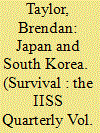

|
|
|
|
|
| Publication |
2012.
|
| Summary/Abstract |
Japan-South Korea security relations seemed to be going so well. The two countries, along with their American ally, met on the sidelines of the June 2012 IISS Shangri-La Dialogue in Singapore and formally agreed to institutionalise a ministerial-level defence trilateral. During the same month, Japan, South Korea and the United States conducted joint naval exercises in the Yellow Sea, not far from China and the Korean Peninsula. At least one respected authority on Korean Peninsula security issues (Peter Beck) has even advocated the establishment of a formal alliance relationship between Tokyo and Seoul.
|
|
|
|
|
|
|
|
|
|
|
|
|
|
|
|
| 10 |
ID:
102407


|
|
|
|
|
| Publication |
2011.
|
| Summary/Abstract |
For much of the past two decades, America's approach toward the Asia-Pacific has been seen by many as highly disjointed, the product either of strategic inattention or the push and pull of US domestic politics. Meanwhile, the rise of China has spawned a cottage industry asserting the existence of a carefully calibrated and highly calculated Chinese grand strategy for the Asian century. Rising China, according to this line, may be biding its time and hiding its capabilities, but it is ultimately bent upon displacing American power in Asia.
|
|
|
|
|
|
|
|
|
|
|
|
|
|
|
|
| 11 |
ID:
105343
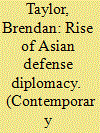

|
|
|
|
|
| Publication |
2011.
|
| Summary/Abstract |
The rise of multilateral defense diplomacy in Asia is an important new phenomenon. In addition to the newly established ADMM+ process and the Shangri-La Dialogue (SLD), ASEAN defense ministers, ASEAN chiefs of defense and ASEAN chiefs of intelligence are now all meeting on a regular basis. Such gatherings were almost unthinkable as recently as a decade ago. This paper seeks to interpret these developments and their implications for the Sino-Australian security relationship. It argues that while these recent developments appear to reflect a deepening of Asian security cooperation, they are actually a manifestation of an intensifying institutional competition, namely between the ASEAN-centered ADMM and the Western-backed SLD. This, in turn, is symptomatic of a broader institutional contestation--reflecting underlying strategic competition--which is becoming a distinctive feature of Asia's emerging security 'architecture.' The paper goes on to argue that China and Australia find themselves on opposite sides of this competition and, particularly in the area of defense diplomacy, are likely to become increasingly important players in fuelling it. The paper concludes by observing why such a dynamic is potentially problematic and offers a modest set of policy recommendations designed to assist Beijing and Canberra in addressing and alleviating their competitive tendencies.
|
|
|
|
|
|
|
|
|
|
|
|
|
|
|
|
| 12 |
ID:
097128
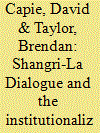

|
|
|
|
|
| Publication |
2010.
|
| Summary/Abstract |
The gradual institutionalization of defence diplomacy is becoming an increasingly prominent and potentially important feature of security dialogue in the Asian region. This stands in marked contrast to Asia's recent history, where across the region multilateral defence or military interactions have traditionally been regarded with suspicion. This article examines the emergence of Asia's most prominent exercise in defence diplomacy: the Shangri-La Dialogue (SLD). Within a relatively short space of time, this forum has developed into one of the most important opportunities for regional defence ministers and senior military officers to meet and exchange views on security issues. Yet despite its growing standing, the SLD has received virtually no scholarly attention. The article begins by reviewing the origins and development of the SLD, before outlining its operating modalities. It seeks to account for the apparent appeal of the SLD, measured in terms of its capacity to consistently attract high-level representation and favourable reviews. The article explores how the SLD might develop in the future and outlines some of the challenges it faces, including the rise of potentially competing mechanisms for defence diplomacy in East Asia. The article closes by outlining a number of areas for further research.
|
|
|
|
|
|
|
|
|
|
|
|
|
|
|
|
| 13 |
ID:
133779
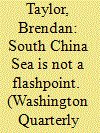

|
|
|
|
|
| Publication |
2014.
|
| Summary/Abstract |
Two important anniversaries arrive in 2014 for protracted South China Sea disputes. January 19 marked 40 years since Chinese and Vietnamese forces clashed over the Paracel Islands, resulting in the deaths of more than 50 Vietnamese personnel and an undisclosed number on the Chinese side-at least the second-largest loss of life to have occurred in any single incident involving these disputed waters. Late 2014 will also mark 20 years since China controversially built structures on the aptly named Mischief Reef in the Spratly Islands, prompting a further series of incidents at sea. Recent reports that China has moved large concrete blocks to Scarborough Shoal-yet another disputed reef that was the scene of an April 2012 standoff between Chinese and Philippines vessels-have sparked concerns in Manila that history is repeating.
|
|
|
|
|
|
|
|
|
|
|
|
|
|
|
|
| 14 |
ID:
187967
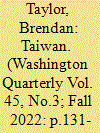

|
|
|
|
|
| Summary/Abstract |
Australia was once famously described as “The Frightened Country”: a strategically anxious nation that sees more danger than opportunity emanating from the Asian continent to its north.1 Consistent with this characterization, Australian security practitioners and pundits alike have for several years now been warning of the prospects of a Taiwan conflict and its potential consequences for Australia.
|
|
|
|
|
|
|
|
|
|
|
|
|
|
|
|
| 15 |
ID:
074747


|
|
|
|
|
| Publication |
2006.
|
| Summary/Abstract |
This article critically reviews the literature on Track 2 security dialogue in the Asia?Pacific and suggests a number of possible avenues for further research. From almost a standing start, Track 2 security dialogue in this part of the world has burgeoned over the past decade and a half. As these institutions and activities have grown, so too has a body of scholarship grown around them which has striven to stay abreast of them and – at least in the case of some of the more prominent second track institutions and activities – to evaluate their influence and effectiveness. Just as viable second track processes must constantly adapt in response to changes in the regional and global security environment, however, this article contends that the scholarship on Track 2 security dialogue needs now to evolve beyond its heavy emphasis upon on the “success” of these institutions and activities. While this criterion remains vital, the article argues that greater analytical attention should also be given to differentiating between the many and varied Track 2 security processes that are currently active in the Asia-Pacific; to developing a closer understanding as to the operating modalities of these institutions and activities; and to better comprehending longitudinal trends in regional Track 2 security dialogue.
|
|
|
|
|
|
|
|
|
|
|
|
|
|
|
|
| 16 |
ID:
062342
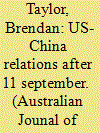

|
|
|
| 17 |
ID:
093784
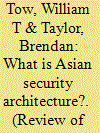

|
|
|
|
|
| Publication |
2010.
|
| Summary/Abstract |
Architecture' has emerged as the new catchphrase in Asian security politics. Despite its growing centrality, insufficient attention has thus far been given to defining the term, often leading to its imprecise usage. This article seeks to redress that shortcoming. It reviews the ways in which various scholars and practitioners have employed the term 'security architecture' and highlights the anomalies that their often differing employment has created. The article proposes a set of guidelines to aid conceptualisation and application of the term. In so doing it establishes criteria to ascertain what 'security architecture' actually exists in the Asian region, and must ultimately exist to assure regional security.
|
|
|
|
|
|
|
|
|
|
|
|
|
|
|
|
|
|
|
|
|